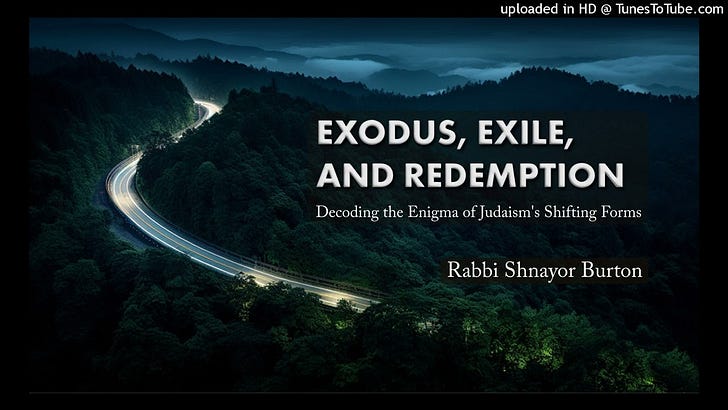EE & R, 2_14: Knowing Hashem: Funding the Divine: The Moral Foundation of Temple Economics
(For the previous installment of "Exodus, Exile and Redemption," click here. For ToC, click here.)
In examining why Yaakov failed to build the Temple, as he had vowed to do, we learned that the purity of the money earmarked for the sacred project was compromised. The designated funds were stained by dishonesty and rendered unfit for financing God’s holy house. Merely pronouncing money “holy” doesn’t make it so; it is the meaning behind the word that does: “Holy” money is such that was obtained with absolute integrity and then consecrated with noble and pure intention. Thus, Yaakov’s failure to perfect his character and progress on the Path of knowing Hashem also hindered him from building His house.
While it may seem self-evident why tainted funds are inappropriate for the holy Temple’s construction, attributing their disqualification to an undefined notion of “spiritual impurity” would be an oversimplification. To truly grasp why certain funds are invalid for the Temple, we need to understand the Temple’s function and, in light of that, how the method of obtaining its funds might undermine that function. What is meant by a “House of Hashem” and what purpose does it serve?
Drawing an analogy with the concept of a holy land will provide insight into understanding Hashem’s holy house. As previously discussed, a land is considered holy when man acts godlike within it, replicating in the human sphere the essential character of God’s perfect universe through kindness, justice and righteousness. If Hashem’s holy land is the place where His good characteristics are put into effect by His human agents, then by analogy, Hashem’s holy house would be the place where those good characteristics reside. Just as an individual resides in a house, from where he goes out to be active in society, throughout the land, so too do Hashem’s good characteristics reside in His house, from where they emerge to be effective and active throughout the land.
How do kindness, justice and righteousness find a home? By being embedded in foundations and walls constructed with those virtues at their core. The edifice is not really the point – the point is what went into erecting the edifice. The essence of the temple, then, is godly virtues: Kindness, justice and righteousness are put into practice in industrious and productive behavior; wealth results; that wealth is formed into something concrete that represents those ideals – e.g., a beautiful building; and that is a holy temple, a home for godly ideals. A house of Hashem is a place where His noble virtues are safeguarded, with its external beauty serving merely as a reflection of its internal moral perfection.1
The temple of Hashem is good, pure money made into a building that concretely symbolizes that goodness and purity. Purity of funds is not a condition for building the Temple, but is rather the Temple itself, the building but a concrete manifestation of divine virtues that inspires people to the abstract ideals it represents.
In the words of Rashi,2 the Temple is “the essence of the Land.” It encapsulates the virtues upon which a good society is founded, and thus it must be built on the foundation of good character: “From everyone who gives it willingly with his heart you shall take My contribution” (Exodus 25:2). The Temple is like the beating heart of the land, the place where the practical activities done throughout the land are preserved as pure ideals in the nation’s collective heart. Like the heart within the body, the Temple pumps spiritual vitality throughout the Land, nourishing it with the principles of divine goodness. If a holy land embodies active goodness, a holy house is where goodness resides and is protected, its core ideals safeguarded and undisturbed by the dynamics of external activities.3
It emerges that to build the Temple with anything less than the purest of intentions and means would be to compromise its very purpose. Yaakov was simply incapable of building a house of perfect kindness, justice and righteousness. His deficiency in knowing Hashem necessarily translated into an inability to build the house that would serve as the center of this divine knowledge in His holy land.
In neglecting to fulfill his vow, Yaakov demonstrated that his return to the Holy Land was incomplete. He didn’t achieve the knowledge of Hashem proffered in his dream, which was associated with the Land. This inability to know Hashem was presaged when Yaakov awoke and declared: “Hashem is in this place, and I did not know” (Genesis 28:16). Yaakov mirrored the stance of an exile, someone distant from full knowledge of Hashem. This unawareness connects the statement made by the revered tsaddik upon his departure from the Land of Israel to exile with the statement made by the wicked Pharaoh, monarch of the land of exile, who openly questioned and denied, saying, “Who is Hashem…? I do not know Hashem” (Exodus 5:2), highlighting the connection between understanding the divine and the sanctification of His holy places.
(For the next installment of "Exodus, Exile and Redemption," click here.)
Why sacrificial worship is so central to the house that represents the good ways of Hashem will be discussed further in this work.


